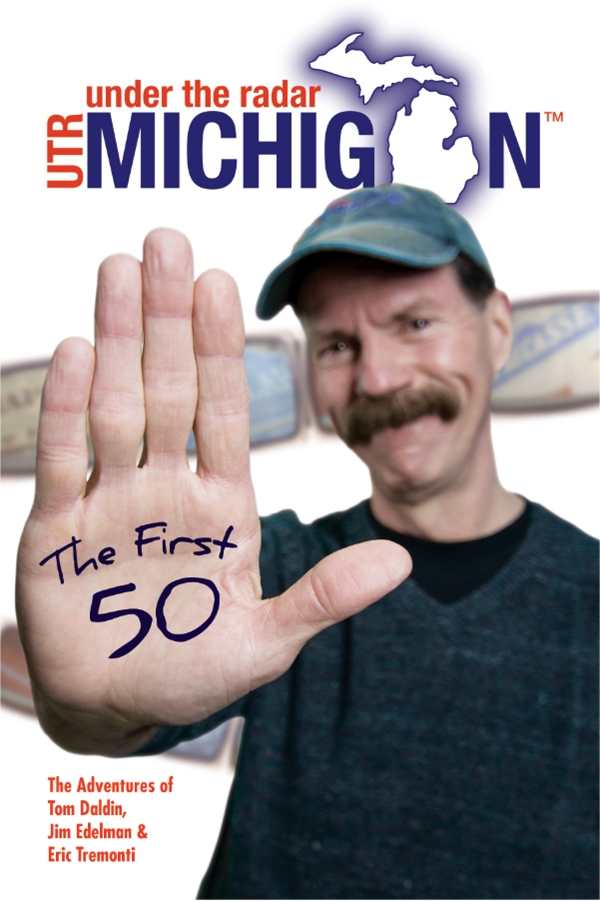Happy 180th to Michigan
Happy 180th Birthday to Michigan, home of our headquarters here at Foreword. (We’re in the pinkie.) The Mitten is looking good for one hundred and eighty years! To celebrate, read up on some Michigan literature.
Detroit is No Dry Bones
The Eternal City of the Industrial Age

Camilo Jose Vergara
University of Michigan Press
Hardcover $55.00 (304pp)
978-0-472-13011-5
Buy: Local Bookstore (Bookshop), Amazon
Vergara not only depicts Detroit’s past and present but also considers the city’s future.
Photographer Camilo Jose Vergara has made his name capturing images of the decline of America’s cities. Perhaps no city has declined more from its heyday to the present than Detroit, and Vergara’s latest work, Detroit is No Dry Bones: An Eternal City of the Industrial Age, tells the story of how a once-thriving industrial center has become home to ruins, graffiti art, and empty spots of urban landscape, yet may also be on the road to recovery.
Some of the most effective photographs in Vergara’s book are those that show the same buildings over time. In a 1998 image, the mansions of Brush Park and the area around them still look lovely; by 2003, the same structures look dilapidated, several trees are gone, and desolation stretches in front of the distant downtown skyline. The old Statler Hotel remains vacant but standing, in a 2001 photo; ten years later, its site is an undeveloped plot. Vergara uses many contrasting images like these, which underscore that Detroit still looked like itself a relatively short time ago.
At the same time, Vergara avoids turning this into mere “poverty porn.” He is on record as wanting parts of cities like Detroit to be preserved as ruins, and there’s an appreciation of keeping the past alive evident throughout the book. He also takes an interest in the city’s art, with some images of statues or signage in the city, and others of the street art that now covers many of the old structures. Photos depict the classic light fixtures of the city’s public library, the Tudor architecture of an old mansion, and the Motown Museum, as well as murals of President Obama, Nelson Mandela, or Rosa Parks created with spray paint on abandoned buildings.
The photos are obviously the bulk of the book, and Vergara is a talented visual storyteller, but the book also features chapters that give the images context. Interviews with locals and stories about the way old buildings have been repurposed offer hints about Detroit’s revival. Detroit is No Dry Bones not only depicts the past and present but also considers the city’s future.
JEFF FLEISCHER (November 10, 2016)
Wicked Takes the Stand
A Tale of Murder and Twisted Deceit in Northern Michigan

Mardi Link
University of Michigan Press
Hardcover $60.00 (448pp)
978-0-472-07169-2
Buy: Amazon
In her strong book about a real-life courtroom tragedy, true-crime author Mardi Link interprets legal jargon for a wide audience and makes the story fascinating.
True crime and courtroom drama meet in Wicked Takes the Stand: A Tale of Murder and Twisted Deceit in Northern Michigan. It makes for an intriguing thriller, where shocking deception tangles with virtuous, talented lawyers—only this story is real.
A man from a small northern Michigan town is found dead and frozen in the back of his own truck. The death is classified as a homicide, and the prosecutor and police have decided on a suspect: Laurie Moore, part owner of the local butcher shop. After his trial and conviction, a woman named Debbie steps up and says that she saw the murder and that others were involved. The years to follow tie up the small-town courts, with Debbie changing her story yet still being protected by the police, who even supply her with room and board, medications, and spending money. For years, five men spend time in jail while their lawyers fight to defend their innocence and clear their names.
Award-winning author and former newspaper reporter Mardi Link has crafted this real-life courtroom drama into a striking book. Her writing style is interest-keeping and enjoyable. She interprets courtroom terms into everyman’s language: “If a trial were a newspaper, closing arguments were the editorials. Not just facts, evidence, and testimony, but the addition of each attorney’s opinion.” While covering all of the information in multiple trials, she also includes interesting tidbits, giving the trial a physical presence. During Laurie Moore’s appeals, Link writes about the case: “Exceptional in complexity, exceptional in legal issues, and exceptional in size. Paperwork on the factual summary alone weighed more than fifty pounds.”
Wicked Takes the Witness Stand creates an accessible account of a series of complicated cases and makes them fascinating.
BETH VANHOUTEN (February 27, 2015)
Under the Radar Michigan
The First 50

Tom Daldin
Jim Edelman
Eric Tremonti
Scribe Publishing Company
Softcover $24.95 (300pp)
978-0-9916021-0-0
Buy: Amazon
Travelers with an interest in exploring the Great Lakes State should dog-ear the pages of this fascinating travel guide.
From Alpena to Ypsilanti, the three-man crew from the Emmy-award-winning PBS television series Under the Radar Michigan has been rolling into towns across the Great Lakes State for four seasons. They’ve compiled their first fifty episodes into Under the Radar Michigan: The First 50, and the written work deserves the same kudos that the filmed version has garnered.
At its core, Under the Radar Michigan is quite simply a recap of past scripts. But while the bulk of the work to create content had already been completed, the effort put into designing the book—with its large, high-quality images, handsome font selections, and indexes sorted by both location and category—makes it a high-quality travel guide.
With Tom Daldin as its host, the television show has been described as an Anthony Bourdain-esque food/adventure show mixed with a small-town news feel. It focuses as much on the people who love their cities as it does on the cities themselves. That attitude carries over to print and is conveyed in well-written vignettes. Each episode becomes a chapter that focuses on trips to two or three Michigan cities.
The goal when Daldin, Jim Edelman, and Eric Tremonti started the project was to discover the “cool people, places, and things that people don’t (but should) know about” in the state, which includes trips to barely-on-the-map locales like Brutus, Carp Lake, Good Hart, Millersburg, and Naubinway. But it also includes five different forays into the city of Detroit to bring attention to lesser-known locations like Dabl’s African Bead Museum and the Alley Project, an outdoor graffiti-art gallery.
The show—and, therefore, the book—is heavy on restaurants, recreation, and retail shops located in ninety different cities and regions. But there are also silly topics, like the Bologna Festival in the small town of Yale, where “they love their bologna and the humor that comes with it.” And there are stories on interesting people, like a Northville dentist who cooks breakfast for his staff each morning and has a “Binky Tree” filled with hundreds of baby pacifiers behind his office.
Under the Radar Michigan: The First 50 is sure to become a dog-eared reference for can’t-miss spots on future adventures.
RICH REZLER (November 27, 2014)
Road Biking Michigan

Cari Noga
Globe Pequot Press
Unknown $14.95 (288pp)
978-0-7627-2803-9
Buy: Local Bookstore (Bookshop), Amazon
Road bicycling has quietly been picking up steam as one of the most popular forms of outdoor recreation. The equipment cost can be minimal, its nonpolluting, its a great way to see the countryside with loved ones, and it is good exercise.
That popularity has not been lost on Globe Pequot Press, which has been publicizing and expanding Road Biking, its state-by-state series of bicycle-touring books. Other volumes tour New Mexico, North Carolina, Northern California, Virginia, Western Pennsylvania, and Oregon; books on several other states, including Wisconsin and Arizona, are forthcoming. Each is penned by an author and bicyclist who is familiar with that region.
This book, the latest in the series, is geared towards readers who want to explore the Great Lakes State on two wheels. The author, an award-winning newspaper reporter, Michigan resident, and veteran cyclist, has also led tour group rides for Michigan Bicycle Touring. She draws from these experiences to present a readable book that will encourage the hesitant to strap on a helmet.
Following the basic format of the Road Biking series, Noga plots out forty suggested routes throughout the state. Each route varies in length, type of terrain, and type of potential obstacles, such as narrow roads and traffic, and is categorized as a Ramble (short and easy), Cruise (intermediate), Challenge (for experienced riders), or Classic (hardest and longest). Each route gets its own chapter, containing practically everything one would need to plan and execute the trip: a map, a set of directions with mileage indicators, restaurants and accommodations one will encounter on the route, and must-see tourist points and local events. The format presents an excellent way for a cyclist to assess, prior to a ride, which one is the best match.
The chapter on the Crystal Lake Ramble, for example, explains that the ride is a 26.4-mile loop on a few rolling hills but with lightly traveled roads. For the unsure, Noga writes, “If you are looking for a great family ride, one within almost everyones ability level, yet with enough highlights and scenery to satisfy more experienced riders, this is it.”
The real motivator is the text. The author knows her roads intimately, and is able to get a bicyclist excited about the ride with tidbits of history and unique attractions. The 40.3-mile Big Rapids Cruise travels through the little village of Paris, which, the reader learns, was mistakenly named after founder John Parish. But the name stuck. Today a rider can see a twenty-foot-high steel reproduction of the Eiffel Tower, erected by high school students in 1980.
Many recreational bicyclists, reluctant to take road trips in unfamiliar territory, will be encouraged to get out on the road and explore the world, thanks to this excellent road-biking series.
KARL KUNKEL (August 18, 2009)
Hannah Hohman
